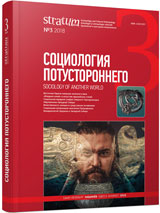Пара бронзовых ножей из музея г. Карс
A Pair of Bronze Knives from the Museum of Kars
Author(s): Svetlana S. Bessonova, Igor V. Bruyako, Necmettin AlpSubject(s): History, Archaeology, Fine Arts / Performing Arts, Cultural history, Visual Arts, Ancient World
Published by: Издательский дом Stratum, Университет «Высшая антропологическая школа»
Keywords: Transcaucasia; Kars; Ziviyeh; Urartu; Scythians; animal style
Summary/Abstract: The pair of bronze knives published here has engravings in animal style and is stored in the museum of Kars (Turkey). The knives were found in Van. From morphological point of view, such knives belonged to the antiquities of Scythian-Saka cultural world (8th—7th cc. BC). Ten other paired sets are known from the same time, while 3 more belong to a later period of the Scythian culture (6th—5th cc. BC). Animals engraved on blades make these knives exceptional, for such complex artistic compositions on blades and handles of knives and daggers are not typical for the early Scythian culture. This tradition should rather be connected with the eastern area of the Scythian-Siberia world of 9th—8th cc. BC. A preliminary analysis of the composition, style and iconography of the animal images and their choice suggests a combination of several artistic traditions, with Assyrian-Urartian and Caucasian (part of Western Asian too) traditions prevailing. The animal style can be manifested in the following ways: side-view images, hawk-nosed ungulates, a big eye, ear and horn combined within one visual element. Zoomorphic and anthropo-zoomorphic beings combined within one linear composition is a common feature for the Kars knives and Kelermess-Sakkyz products manufactured by some local craftsmen, whether for the Scythian leaders during their presence in Western Asia, or for some other Iranian ethnic groups.
Journal: Stratum plus. Археология и культурная антропология
- Issue Year: 2018
- Issue No: 3
- Page Range: 221-264
- Page Count: 44
- Language: Russian
- Content File-PDF

